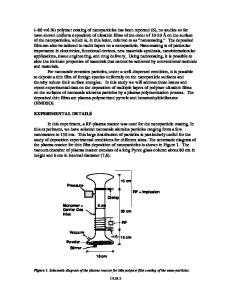Coating of Ultrathin Polymer Films on Carbon Nanotubes by a Plasma Treatment
- PDF / 3,209,980 Bytes
- 7 Pages / 612 x 792 pts (letter) Page_size
- 52 Downloads / 341 Views
I3.19.1
Coating of Ultrathin Polymer Films on Carbon Nanotubes by a Plasma Treatment Peng He, Jie Lian1, Donglu Shi, Lumin Wang1, David Mast2, Wim J. van Ooij, and Mark Schulz3 Dept. of Chemical and Materials Engineering, 2Dept. of Physics, 3Dept. of Mechanical Engineering, University of Cincinnati Cincinnati, OH 45221 1 Dept. of Nuclear Engineering and Radiological Science, University of Michigan Ann Arbor, MI 48109 ABSTRACT Ultrathin polymer films have been deposited on both single- and multi-wall carbon nanotubes using a plasma polymerization treatment. HRTEM experiments showed that an extremely thin film of the pyrrole layer (2-7 nm) was uniformly deposited on the surfaces of the nanotubes including inner wall surfaces of the multi-wall nanotubes. Time-of-Flight Secondary ion mass spectroscopy (TOFSIMS) experiments confirmed the nanosurface deposition of polymer thin films on the nanotubes. The deposition mechanisms and the effects of plasma treatment parameters are discussed. INTRODUCTION Nanotubes are used in many applications because of their desirable bulk properties. Unfortunately, the surface of the nanotubes is often not ideal for the particular application. The ability to deposit well-controlled coatings on nanotubes would offer a wide range of technological opportunities based on changes to both the physical and chemical properties of the nanotubes. Atomic layer controlled coatings on nanotubes, for example, would allow nanotubes to retain their bulk properties but yield more desirable surface properties. These ultrathin coatings could act to activate, passivate or functionalize the particle to achieve both desirable bulk and surface properties. For instance, nanophase polymers typically consist of a hard phase dispersed in a soft phase to achieve specific enhanced properties. “Hard” nanotube serves as the hard phase. By manipulation of the physical, chemical and optical properties of the “hard” phase nanotubes, tunable materials properties can be achieved. A key aspect of being able to manipulate the properties of the nanotubes is the surface treatment of the nanotubes by various processing techniques. This technology produces high-tech properties with the low cost normally associated with plastics. Another example is the consolidation at low temperatures via so-called nanoglue. When an adhesive thin film is coated on the nanotube surfaces, these nanotubes can be consolidated at a temperatures. However, this method requires the adhesive thin film to be extremely thin and uniform. Therefore the volume percent of the polymer is limited to only a few percent. In this way, the bulk mechanical properties can be maintained. Depositions of ultrathin films with unique physical, chemical and biological properties on nanotubes can also have great potential in many engineering applications.
I3.19.2
On the surface of the nanotubes, an extremely thin layer of polyacrylic film can be coated by a plasma treatment. The polyacrylic film will react with metallic ions in water. As a result of the high surface-to-volu
Data Loading...











